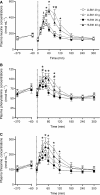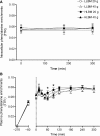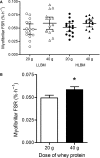The response of muscle protein synthesis following whole-body resistance exercise is greater following 40 g than 20 g of ingested whey protein
- PMID: 27511985
- PMCID: PMC4985555
- DOI: 10.14814/phy2.12893
The response of muscle protein synthesis following whole-body resistance exercise is greater following 40 g than 20 g of ingested whey protein
Abstract
The currently accepted amount of protein required to achieve maximal stimulation of myofibrillar protein synthesis (MPS) following resistance exercise is 20-25 g. However, the influence of lean body mass (LBM) on the response of MPS to protein ingestion is unclear. Our aim was to assess the influence of LBM, both total and the amount activated during exercise, on the maximal response of MPS to ingestion of 20 or 40 g of whey protein following a bout of whole-body resistance exercise. Resistance-trained males were assigned to a group with lower LBM (≤65 kg; LLBM n = 15) or higher LBM (≥70 kg; HLBM n = 15) and participated in two trials in random order. MPS was measured with the infusion of (13)C6-phenylalanine tracer and collection of muscle biopsies following ingestion of either 20 or 40 g protein during recovery from a single bout of whole-body resistance exercise. A similar response of MPS during exercise recovery was observed between LBM groups following protein ingestion (20 g - LLBM: 0.048 ± 0.018%·h(-1); HLBM: 0.051 ± 0.014%·h(-1); 40 g - LLBM: 0.059 ± 0.021%·h(-1); HLBM: 0.059 ± 0.012%·h(-1)). Overall (groups combined), MPS was stimulated to a greater extent following ingestion of 40 g (0.059 ± 0.020%·h(-1)) compared with 20 g (0.049 ± 0.020%·h(-1); P = 0.005) of protein. Our data indicate that ingestion of 40 g whey protein following whole-body resistance exercise stimulates a greater MPS response than 20 g in young resistance-trained men. However, with the current doses, the total amount of LBM does not seem to influence the response.
Keywords: Fractional synthesis rate; intracellular signaling proteins; lean body mass; protein dose‐response.
© 2016 The Authors. Physiological Reports published by Wiley Periodicals, Inc. on behalf of the American Physiological Society and The Physiological Society.
Figures






References
-
- Anthony, J. C. , Anthony T. G., and Layman D. K.. 1999. Leucine supplementation enhances skeletal muscle recovery in rats following exercise. J. Nutr. 129:1102–1106. - PubMed
-
- Apro, W. , and Blomstrand E.. 2010. Influence of supplementation with branched‐chain amino acids in combination with resistance exercise on p70S6 kinase phosphorylation in resting and exercising human skeletal muscle. Acta Physiol. (Oxf) 200:237–248. - PubMed
-
- Atherton, P. J. , Etheridge T., Watt P. W., Wilkinson D., Selby A., Rankin D., et al. 2010. Muscle full effect after oral protein: time‐dependent concordance and discordance between human muscle protein synthesis and mTORC1 signaling. Am. J. Clin. Nutr. 92:1080–1088. - PubMed
-
- Baechle, T. R. , and Earle R. W.. 2008. Essentials of strength and conditioning. Human Kinetics, Champaign, IL.
-
- Biolo, G. , Maggi S. P., Williams B. D., Tipton K. D., and Wolfe R. R.. 1995. Increased rates of muscle protein turnover and amino acid transport after resistance exercise in humans. Am. J. Physiol. 268:E514–E520. - PubMed
Publication types
MeSH terms
Substances
LinkOut - more resources
Full Text Sources
Other Literature Sources

